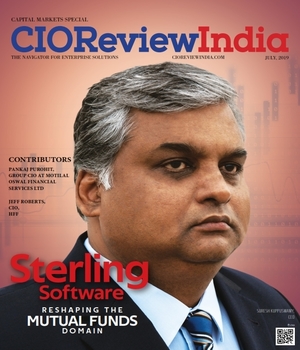
Key Tech Trends for Capital Markets
Dipak Rout, Head-IT, ArihantCapital Markets Ltd | Tuesday, 10 July 2018, 04:35 IST
 Arihant Capital Markets Limited is one of the leading financial services companies in India offering a gamut of products and services including securities, currency and commodities broking, depository services, distribution of financial products and merchant banking to a substantial and diversified clientele.
Arihant Capital Markets Limited is one of the leading financial services companies in India offering a gamut of products and services including securities, currency and commodities broking, depository services, distribution of financial products and merchant banking to a substantial and diversified clientele.
Every industry is feeling the effects of the information revolution, but capital markets are a bit different. A perfect
storm of stagnating revenues, increased competition and weak financial returns a combination we’re calling ‘compressive disruption’- is forcing capital markets firms to evolve and reinvent in their own way. Between now and 2022, the capital markets industry will be shaped by automation. Change is neither cheap nor easy, but firms could begin to align their organizations.
Technology serves as a key driver of value migration in the capital markets industry. While speed, informational advantage, efficient customer flow, and effective use of proprietary capital have always been essential aspects of a profitable market-making business, the way these elements are implemented is changing dramatically.
Blockchain will make Capital Markets more efficient
One of the most hyped technologies today, Blockchain is estimated to be the platform that is going to store 10 percent of global GDP by 2027. Blockchain, or distributed ledger technology, will also become more critical for capital markets firms. Blockchain can create the smart contracts enabled with the encryption for transactions, [creating] distributed records. This will help in using real-time transparent data and create efficient settlement and transaction processing.
Distributed ledger technology, or DLT, can be used for issuing and transferring securities and could eliminate the need for intermediaries that provide settlement and depository functions, DLT can be logical, efficient alternative to allow seamless and secure data transmission throughout the capital markets ecosystem. Blockchain can bring significant efficiency to current post-trade processes and can potentially shorten the settlement cycle.
With increased transparency, the real-time data availability will enable major benefits into the operations side of trade and settlement data reconciliation and will eliminate the possibilities of disputes among all the counterparties. The cash settlement will start occurring in real-time, as the next trade update will be among all the participating entities.
Big Data and Analytics
Today, the need of capital markets is not limited to consuming required data for references and algorithmic calculations, but they also require the ability to analyze data efficiently and swiftly. Underlying data must provide greater insight and control over complex processes for managing cash flow and anticipating risks. It should also automate transactional processes along with real-time analytics. From client servicing to risk and portfolio management, Big Data analytics plays an important role to provide new level of customized services.
Artificial Intelligence and Machine Learning
The industry is moving towards conversational commerce by using Chat Bots, AI and NLP at various functional levels. Chat Bots and Natural Language with advance analytics are helping capital markets to lower down the operating cost for some important functions, releasing employees’ bandwidth for critical and higher level tasks. Systems that can learn, adapt, and respond autonomously offer a new area of interest for various capital market technology players.
• Artificial Intelligence will enhance investing and decision-making- AI is set to take off in capital markets, largely because it enhances profitability. AI will also be used in other ways in capital markets. Already Industry are using machine learning to improve productivity across a range of functions, including risk management, trading and fraud detection. Firms are also using natural language processing and chatbots to transform how they interact with customers. Machine learning can be used for anti-money laundering (AML) and know-your customer (KYC) solutions, especially as regulations have forced financial institutions to improve their data management capabilities.
• AI will also help automate processes- AI will also help capital markets firms become more efficient, especially for back-office tasks. Process automation can help the capital market firms to replace manual legacy systems, maintain the audit trail, make the system compliant with AML, KYC and other regulations, [reconcile] the various reports and also integrate middle and back-office processes.
Robotic Process Automation
Robotic process automation will bring efficiency in terms of time and money, simplify the processes and can redefine the business models. RPA will help capital markets firms boost efficiencies. RPA can help increase efficiency and reduce costs by 25 to 50 percent in some organizations. RPA can help with client on boarding, revenue recognition, expense validation, accounting processes, operational and financial reconciliation, and reporting.
RPA not only helps in reducing transaction time, but also offers accuracy improvement and effort reduction in use cases like transaction reporting, reconciliations, and settlements and payments processes. Client onboarding, reconciliation, reporting, and corporate actions are some of the business areas where it would be very effective with or without AI and NLP.
Importance of Data Protection
Capital markets firms should build their resilience because attackers themselves are resilient. They are able to evolve rapidly to come up with new ways to attack. If a firm has modelled a scenario and thought about a way to execute an attack, the criminals have already thought of it too. They are constantly scanning for the next vulnerability, which makes most firms reactionary in protecting against the next attack.
With technology-based platforms and high speed algorithmic systems becoming key fulcrums for trading activities, the regulatory focus is on bolstering the existing framework and ensure a robust firewall is in place to thwart possible cyber attacks.
Thus, Capital markets firms will need to invest in data protection and management technology to comply with the regulations. At the heart of GDPR is the requirement to understand the complete data structure and data workflow within an institution.
CIO Viewpoint
BSE - Traversing the Cycle of Continuous...
By CIOReviewIndia Team
Enabling Financial Inclusion on a Digital Platform
By Manoj Kumar Nambiar, Managing Director and Arvind Murarka, Head IT at Arohan Financial Services (P) Limited
Key Tech Trends for Capital Markets
By Dipak Rout, Head-IT, ArihantCapital Markets Ltd
CXO Insights
By Supriyo Dasgupta, IT Applications Head, Compass Group India
The T Minus 10 Of AI - Getting Started with the...
By Sushil Kumar Tripathi, AVP - Technology, Kellton Tech
Digitization in Insurance Industry



.jpg)
.jpg)






